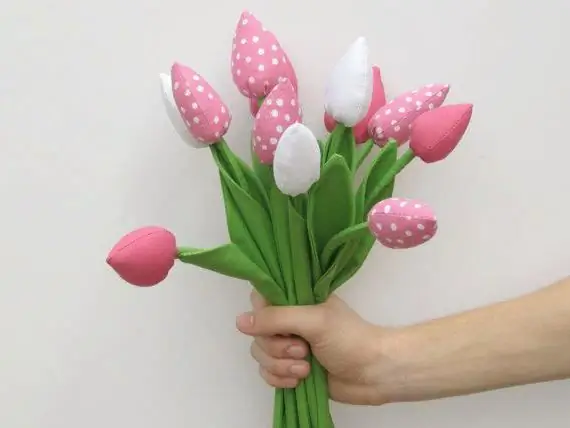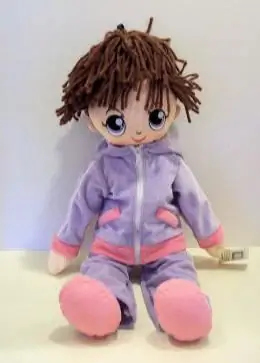
Inhaltsverzeichnis:
- Autor Sierra Becker [email protected].
- Public 2024-02-26 04:44.
- Zuletzt bearbeitet 2025-01-22 22:11.
Wenn der Frühling kommt, erblüht die Natur und der Duft der Blumen erfüllt die Luft. Und welche Pflanzen werden mit den ersten Frühlingssonnenstrahlen in Verbindung gebracht? Natürlich mit Tulpen - zart, duftend, mit einer ganzen Palette saftiger Farbtöne. Leider h alten zerbrechliche Knospen nicht lange, aber ich möchte, dass das Blumenarrangement das ganze Jahr über den Raum schmückt. Anhand des Tulpenmusters aus Stoff in diesem Artikel lernen Sie, wie Sie einen originellen Blumenstrauß nähen.

Stoffe und Werkzeuge zum Nähen von Blumen
Ab Anfang März erscheinen Tulpen in allen Farben des Regenbogens im Angebot. Daher können Sie zum Nähen einer Blume jeden Baumwoll- oder Satinstoff in leuchtenden und satten Farben verwenden. Das Material kann einfarbig oder mit einem kleinen Muster sein. Graue und braune Farben sollten natürlich ausgeschlossen werden, da der Strauß sonst düster und unattraktiv ausfällt und am wenigsten an den Frühlingsanfang erinnert.
Da diese Kreativität ein Höhenflug ist, ist beim Nähen von Blumen nach einem Tulpenmuster aus einem Stoff eine Kombination verschiedener Stoffmuster in einer Anlage erlaubt. Blumensträuße in Rosa, Weiß, Gelb, Lila, Rot und Grün wirken natürlichSchattierungen. Sie können farbigen dünnen Filz verwenden. Daraus werden die Knospen weich mit einem samtigen Effekt.
Zusätzlich zum Stoff zum Nähen benötigen Sie einen Füller, der der Knospe mehr Volumen verleiht. Sie benötigen außerdem Fäden, die zu den Farben der Stoffe passen. Zum Nähen des Stiels und der Blätter müssen Sie grünes Material kaufen. Und natürlich brauchst du ein Tulpenmuster aus Stoff, eine Nähmaschine, einen Marker, ein Lineal und eine Schere.
Knospe erstellen
Die Basis der Blume kann auf verschiedene Arten genäht werden. Zum Beispiel nicht nur aus zwei, sondern auch aus drei und vier Teilen. Dazu benötigen Sie:
- Das aus einem dicken Blatt Papier ausgeschnittene Tulpenmuster auf den Stoff übertragen und die gewünschte Anzahl Knospenelemente aus dem Stoff ausschneiden.
- Lassen Sie an den Rändern des Teils eine Zugabe von ca. 5 mm zum Vernähen.
- Schneiden Sie die Teile der Blüte aus und richten Sie sie mit der rechten Seite nach oben zu einer Knospe aus.
- Nähen Sie die verbundenen Seiten weiter, lassen Sie die Unterseite zum Füllen, bügeln Sie den Stoff und drehen Sie den resultierenden Rohling.
- Dann muss die Knospe mit Polsterpolyester gefüllt werden, eine Heftnaht entlang der Kante legen und das Teil abziehen, sodass eine Blume entsteht.

Stielnähen
Die Länge des Astes kann beliebig gewählt werden, ganz wichtig, die Proportionen einh alten. Der Stiel muss mindestens doppelt so lang sein wie die Knospe. Für die Schneiderei benötigen Sie einen grünen Stoff. Schablone auf das Material übertragen und unter Berücksichtigung der Zugaben ausschneiden. F alten Sie das Werkstück entlang der langen Seite in zwei Hälften und nähen Sie eine Schreibmaschine entlang der Kante an und bearbeiten Sie sieauch der schmale Teil. Tulpenstiele müssen fest und stabil sein, da sie in der Hand geh alten, in eine Vase gestellt oder zur Dekoration eines Raumes verwendet werden. Daher ist ein synthetischer Winterizer oder Watte nicht ausgeschlossen, aber es ist klüger, einen festen Gegenstand in Form eines Bleistifts, eines Sushi-Sticks, eines langen Spießes, eines dicken Drahtes und anderer der Größe angemessener Gegenstände zu verwenden.
Drehen Sie das Teil durch das unvernähte Loch und stecken Sie den Stab in die entstandene Hülle. Füllen Sie die Hohlräume mit Hollow Fiber und setzen Sie die fertige Knospe auf den Stiel. Sie können eine andere Methode verwenden, bei der das ausgewählte Element einfach mit einem grünen Tuch überklebt wird.
Blätter machen
Um Stofftulpen natürlicher zu machen, ist es notwendig, sie groß zu nähen, was für diese Blume charakteristisch ist. Übertragen Sie das Blütenblattmuster auf das gleiche Material, aus dem der Stiel hergestellt wurde, und schneiden Sie zwei Stücke für jedes Tulpenblatt. Verbinden Sie die Elemente mit der linken Seite nach außen und nähen Sie die Kanten. Drehen Sie dann das Blatt auf links, bügeln Sie es und wickeln Sie den Stiel darum und nähen Sie die Details an der Basis.

Aus dem Artikel hast du gelernt, wie man Tulpen aus Stoff näht. Nachdem Sie mehrere Blumen kreiert haben, können Sie einen Strauß daraus machen und sie Ihrer geliebten Mutter oder einem engen Freund schenken.
Empfohlen:
Giraffenmuster. Wie man mit eigenen Händen eine Giraffe aus Stoff näht

In dem Artikel werden wir uns überlegen, wie man eine Spielzeuggiraffe nach einem Muster näht. Sie können es selbst zeichnen oder die folgenden Optionen als Muster nehmen. Interessant sehen eine einteilige Giraffe und eine Variante aus Einzelteilen aus
Wie webt man eine Blume aus Gummibändern? Methoden zur Herstellung eines Blumenanhängers gehäkelt und auf einem Webstuhl

Wenn du dich fragst, wie man eine Blume aus Gummibändern webt, probiere verschiedene Möglichkeiten aus, beginnend mit den einfachsten. Liebevolle Anhänger können dann als Schlüsselanhänger oder dekoratives Detail für modische Fanny Lum-Gummibandarmbänder verwendet werden
Wie man Buchstaben aus Stoff näht: eine Meisterklasse

Suchen Sie nach originellen Dekorationslösungen für Ihr Zuhause? Buchstaben sind eine ungewöhnliche Innendekoration. Sie bestehen aus unterschiedlichen Materialien: Holz, Pappe, Pappmaché, Gips und Salzteig. Es gibt flache und dreidimensionale Modelle. Nach dem Studium unserer Meisterklasse lernen Sie, wie Sie mit Ihren eigenen Händen Volumenbuchstaben aus Stoff nähen
Wie man mit eigenen Händen Haare für eine Puppe macht: eine Meisterklasse. Wie man Haare an eine Puppe näht

Dieser Artikel beschreibt alle möglichen Ideen und Möglichkeiten, um Haare für Textilpuppen und Puppen zu kreieren, die ihr Aussehen verloren haben. Haare für eine Puppe selbst zu machen ist viel einfacher als es auf den ersten Blick scheint, eine detaillierte Beschreibung hilft Ihnen dabei, dies sicherzustellen
Wie man einen Affen aus Stoff näht: Muster, Meisterklasse, Foto, Diagramm

Spielzeug ist immer ein Vergnügen, weil es sich angenehm anfühlt und aus hellen Stoffen genäht ist. Wir bieten Ihnen mehrere Meisterkurse zum Thema Nähaffen an, die für 2016 relevant sind
